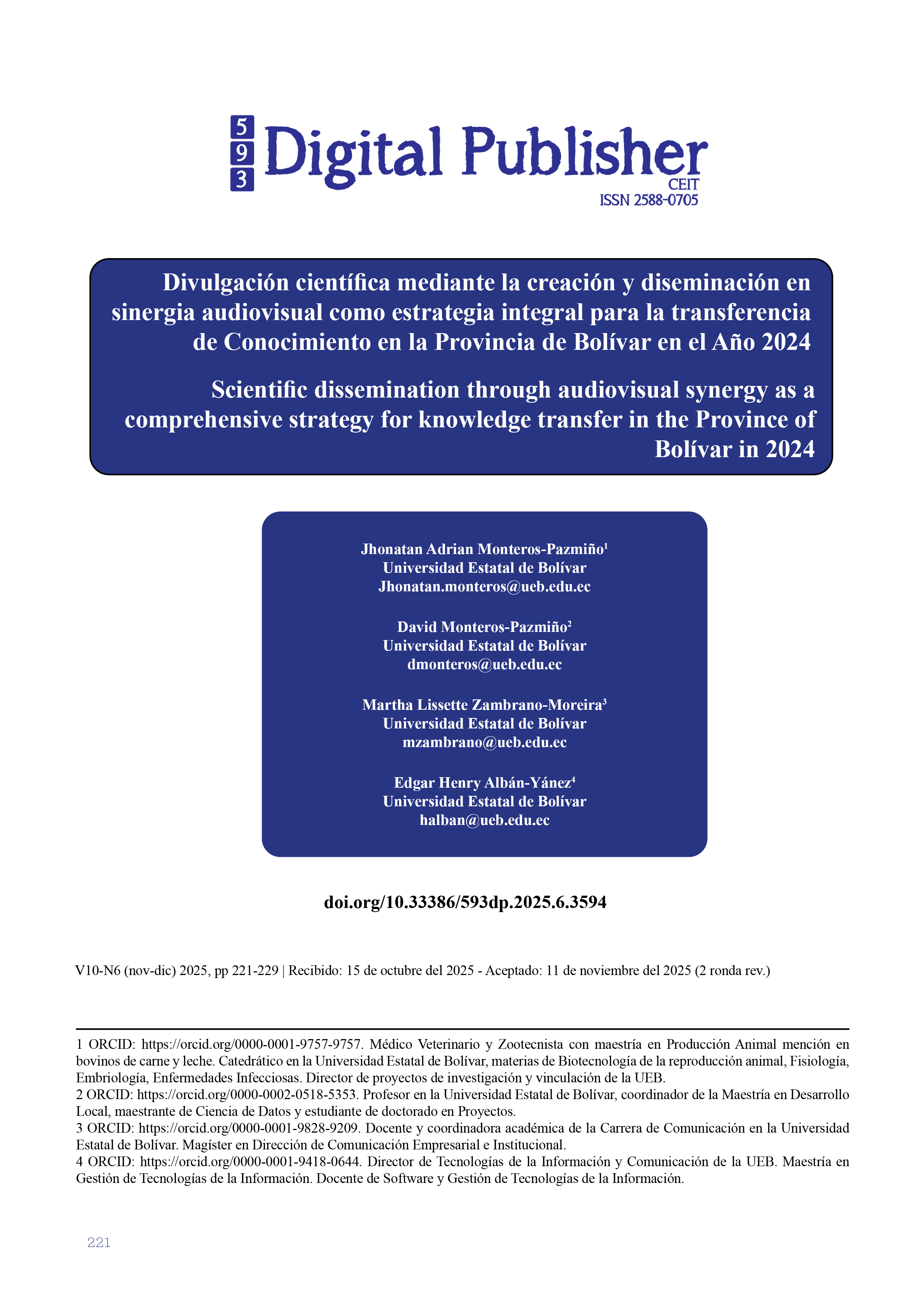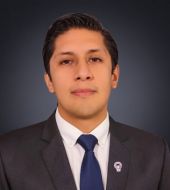Scientific dissemination through audiovisual synergy as a comprehensive strategy for knowledge transfer in the Province of Bolívar in 2024
Main Article Content
Abstract
This article analyzes scientific dissemination as a comprehensive strategy for knowledge transfer in the veterinary field in the Province of Bolívar, through the creation and dissemination of audiovisual materials. General objective: to democratize the dissemination of scientific knowledge produced at the Universidad Estatal de Bolívar through specialized videos that strengthen the local scientific culture. The methodology followed a qualitative approach with a descriptive–exploratory design and a documentary–narrative character. Semi-structured interviews were conducted with the rector at the Laguacoto campus, recorded in audiovisual format, along with technical visits to veterinary science laboratories. These spaces were documented on video to show research, teaching, and extension practices. The material was curated and edited, also integrating institutional and normative sources, in order to build a coherent narrative between the university and the community. The results indicate that scientific education is essential for the social appropriation of practices in animal health, biosecurity, and welfare. Recent literature shows that audiovisual resources from narrative videos to microcontent on TikTok and Instagram enhance reach and comprehension, while YouTube remains a stable repository. Emerging platforms such as Bluesky are gaining relevance as academic debate spaces. However, risks related to misinformation, digital fatigue, and the environmental footprint of short videos are highlighted, demanding responsible strategies. In conclusion, scientific dissemination through audiovisual media strengthens veterinary knowledge transfer, diversifies communication channels, and promotes sustainable social impact, provided it is guided by ethical, pedagogical, and environmental principles.
Downloads
Article Details

This work is licensed under a Creative Commons Attribution-NonCommercial-ShareAlike 4.0 International License.
1. Derechos de autor
Las obras que se publican en 593 Digital Publisher CEIT están sujetas a los siguientes términos:
1.1. 593 Digital Publisher CEIT, conserva los derechos patrimoniales (copyright) de las obras publicadas, favorece y permite la reutilización de las mismas bajo la licencia Licencia Creative Commons 4.0 de Reconocimiento-NoComercial-CompartirIgual 4.0, por lo cual se pueden copiar, usar, difundir, transmitir y exponer públicamente, siempre que:
1.1.a. Se cite la autoría y fuente original de su publicación (revista, editorial, URL).
1.1.b. No se usen para fines comerciales u onerosos.
1.1.c. Se mencione la existencia y especificaciones de esta licencia de uso.
References
American Association Veterinary Medical Colloges. (2025). Enhancing Spectrum of Care Preparation in Veterinary Education Programs: An Implementation Strategies Guide. https://www.aavmc.org/wp-content/uploads/2025/04/AAVMC-SOC-Guide_2025.pdf?utm_source=chatgpt.com
Brown, M. A. (2020). Educating the future of science and medicine. En Veterinary Sciences (Vol. 5, Número 2, p. 34). MDPI. https://www.mdpi.com/2306-7381/5/2/34
Loor, O. del M., & Cumba, E. A. (2025). Narrativas audiovisuales para la divulgación científica en la red social TikTok. Revista Enfoques de la Comunicación, 13, 579-604.
Marx, C. L., & König, L. M. (2025). Comparing the effectiveness of animated videos and talking‐head videos in science communication. British Journal of Health Psychology, 30(1), e12786. https://doi.org/10.1111/bjhp.12786
Mills, P. C. (2024). Education and Communication in Veterinary Clinical Practice. Animals : an Open Access Journal from MDPI, 14(17), 2622. https://doi.org/10.3390/ani14172622
Montes, M., Wargo, J., Jones-Jang, S. M., Quan, S., Lai, B., & Riobueno-Naylor, A. (2025). Evaluating video-based science communications practices: A systematic review. Journal of Science Communication, 24(3), V01. https://doi.org/10.22323/2.24030901
Mooney, M. (2023, noviembre 7). Texas A&M physics professor becomes viral sensation. Axios. https://www.axios.com/local/dallas/2023/11/07/texas-am-physics-professor-goes-viral
Moran, R. E., & Knesl, O. (2025). How can the veterinary profession tackle social media misinformation? https://doi.org/10.2460/javma.24.10.0665
Pérez, C. C. (2025). Use of Instagram as an Educational Strategy for Learning Animal Reproduction. Veterinary Sciences, 12(8), 698. https://doi.org/10.3390/vetsci12080698
Pettan, C., Figueroa, D. P., Cediel, N., Kahn, L. H., Martins, A. F., & Biondo, A. W. (2022). Editorial: Challenges and successes of One Health in the context of planetary health in Latin America and the Caribbean. Frontiers in Public Health, 10. https://doi.org/10.3389/fpubh.2022.1081067
Pettan, C., Martins, A. F., de Abreu, D. P. B., Brandão, A. P. D., Barbosa, D. S., Figueroa, D. P., Cediel, N., Kahn, L. H., Brandespim, D. F., Velásquez, J. C. C., Carvalho, A. A. B., Takayanagui, A. M. M., Galhardo, J. A., Maia-Filho, L. F. A., Pimpão, C. T., Vicente, C. R., & Biondo, A. W. (2021). From the Approach to the Concept: One Health in Latin America-Experiences and Perspectives in Brazil, Chile, and Colombia. Frontiers in Public Health, 9, 687110. https://doi.org/10.3389/fpubh.2021.687110
Rein, B. (2023a). Making Science Education More Accessible: A Case Study of TikTok’s Utility as a Science Communication Tool. Neuroscience, 530, 192-200. https://doi.org/10.1016/j.neuroscience.2023.08.021
Rein, B. (2023b). Making Science Education More Accessible: A Case Study of TikTok’s Utility as a Science Communication Tool. Neuroscience, 530, 192-200. https://doi.org/10.1016/j.neuroscience.2023.08.021
Savage, M., medios, M. S. E. de, & Savage, M. (2025, septiembre 1). Science research gets more engagement on Bluesky than X, study finds. The Guardian. https://www.theguardian.com/technology/2025/sep/01/science-research-gets-more-engagement-on-bluesky-than-x-study-finds
Veenema, N. J., Hierck, B. P., Bok, H. G. J., & Salvatori, D. C. F. (2024). Links between learning goals, learning activities, and learning outcomes in simulation-based clinical skills training: A systematic review of the veterinary literature. Frontiers in Veterinary Science, 11. https://doi.org/10.3389/fvets.2024.1463642





